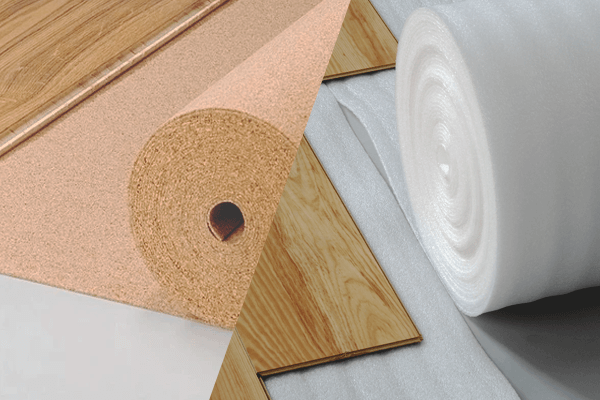Floor underlayment carries numerous benefits. It absorbs sound, hides imperfections of the floor, and works as a vapor barrier to prevent floor damage from moisture.
You can find different types of underlayment in the market. Cork and foam are the most popular types of underlayment among them. Both have upsides and downsides. For example, cork underlayment is eco-friendly and reduces the sound better. On the other hand, foam underlayment is affordable and easy to install.
But when it comes to choosing the best one between cork and foam underlayment, it will be a bit tricky. Now, you may ask- Cork vs Foam underlayment: Which is the best for flooring?
To get the answer to this question, keep reading this comparison guide till the end.

Contents
Cork Underlayment
Cork is a type of eco-friendly underlayment as it is made of natural ingredients, i.e from the bark of cork trees. The market-best cork underlayments arise from Portugal. The thickness of the cork underlayment will be between 3-6 mm.
How Good Is Cork Underlayment
You can’t end the benefits of cork underlayment by counting. It’s ecologically sustainable, can resist mold & mildew, and adds insulation. Therefore, it can absorb the sound of footsteps optimally.
Generally, cork is harvested from the bark of the cork trees without harming the trees. It’s eco-friendly and durable. Due to its longevity, you don’t need to replace the cork underlayment frequently.
Nonetheless, mold & mildew can’t invade your home because of the antimicrobial nature of cord underlayment.
Above all, optimum sound-absorbing capacity is what most laminate floor owners love about cork underlayments.
Cost
The cost of cork underlayments is a bit pricey compared to other underlayment types. It takes between $0.50-$0.75 per sq foot to get this durable underlayment.
Foam Underlayment
Foam is the most common and basic type of underlayment you can find in the market. It comes in different thicknesses and rolls of various widths and lengths. Like cork underlayments, the thickness of foam underlayment will also be between 3-6 mm.
How Good Is Foam Underlayment
The benefits you will enjoy by installing foam underlayment are uncountable. It’s affordable, comfortable & adds cushioning, and of course, it absorbs sound. Several foam underlayment types come with a vapor or moisture barrier. It helps to protect your laminate base from flooding. Also, it will shield your subfloor from moisture damage.
However, easy installation is the best feature people love most about the foam underlayment. Even a newbie who just gets his feet wet on the laminating floor can also install it. It comes in large rolls. So, you can cut it according to your needs.
Cost
The price of foam underlayment varies depending on the type of foam underlayment type. For example, basic foam underlayment will cost you around $0.22 to $0.30 per square foot. On the other hand, you should spend $0.30-$0.45 per sq foot to get sound-reducing foam.
Cork Vs. Foam Underlayment: Which is the Best?
In this chapter, we will bring both cork and foam underlayment head to head. We will break down the key differences between these two underlayment types. As a result, you can decide which will be best for your laminate floor.
Material
The first difference between cork and foam underlayment is the material they use. Cork underlayment uses the bark of cork trees as its built-in material. As it uses natural ingredients, it’s eco-friendly and durable.
On the other hand, foam underlayment is made of foam, fibers, and rubbers. You know that rubber is not eco-friendly and not as durable as cork underlayment.
Comfort Level
Both underlayment types add cushion. Indeed, you feel soft and comfortable if you lay underlayment beneath your laminate floor or carpeted base. But, foam underlayment is a bit soft compared to the cork underlayment.
Noise-Reduction
When it comes to absorbing sound, cork underlayment will beat the foam underlayment. The natural ingredient and density of cork make it an ideal choice for most condo & apartment owners to absorb the sound of footsteps. However, some foam underlayments use fibers & rubbers which can also absorb sound.
Thickness
There is no difference between cork or foam underlayments if we measure both underlayment types by thickness. You can find underlayments that come in various thicknesses. For example, both underlayment types available are between 3-6 mm.
Eco-friendliness
Cork underlayment is the winner over foam one when it comes to eco-friendliness. The cork underlayment is made of the bark of cork trees. It doesn’t bring any damage to the cork trees. Indeed, cork underlayment is eco-friendly and ecologically sustainable. On the other hand, foam underlayment is made of foam or rubber. It starts smelling over time.
Installation
Foam underlayment is simple to install compared to cork underlayment. It comes in large rolls, and you can cut it according to your specific needs for easy installation. You can install it under any floorings.
On the other hand, cork is not as easy as foam underlayment to install. We don’t recommend you install the cork underlayment in the basement and bathroom areas.
Price
Foam underlayment is an affordable option in the market. It costs you just $0.22 to $0.30 per square foot. On the other hand, the cork underlayment is a bit pricey. You should spend around $0.50-$0.75 per sq foot.
FAQs
Does cork get moldy?
No, cork never gets moldy. Cork is hydrophobic, and cork never allows the mold & mildew to grow due to its near impermeability. In other words, cork doesn’t wet easily, which discourages the mold & mildew from growing underneath it.
Does cork absorb humidity?
No, cork never absorbs humidity because it’s humidity-proof. It also prevents mold and mildew growth. So, you don’t need to worry about humidity.
Is cork underlayment mold resistant?
Yes, cork underlayment is mold-resistant. It is a natural thermal and acoustical insulator, which makes it naturally empowered to resist mold and mildew from growing underneath it.
Is cork underlayment good for laminate flooring?
Yes, cork underlayment is good for your laminate flooring. It reduces noise and has antimicrobial properties. Because of it, mold and mildew can’t grow between the laminate base and the subfloor. Therefore, it provides enough cushion and absorbs the sound.
Can you use cork underlayment under vinyl plank flooring?
No, you can’t use cork underlayment under your vinyl plank flooring. Indeed, vinyl hates spongy, squishy, and nice feeling underneath it.
What kind of foam is used for laminate flooring?
You can use polyethylene foam as an underlayment for laminate flooring. It has a layer of plastic attached to the underlayment, which works as a moisture or vapor barrier.
Conclusion
Both cork and foam underlayment have upsides and downsides. Cork underlayment provides more sound-absorption capacity than foam underlayment. Therefore, it’s eco-friendly, long-lasting, and works as a moisture barrier. But the downside is it’s a bit pricey.
On the other hand, foam underlayment is affordable and easy to install. You can install it in every area of your house, including the basement and bathrooms. But the con is- it’s not eco-friendly.
We recommend the cork underlayment most though it is expensive. It’s durable, absorbs sound better, and prevents mold & mildew from growing underneath the floor.
